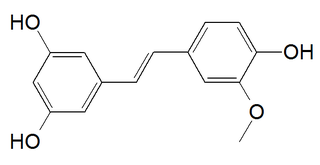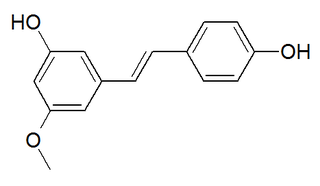
Gnetophyta is a division of plants, grouped within the gymnosperms, that consists of some 70 species across the three relict genera: Gnetum, Welwitschia, and Ephedra. Fossilized pollen attributed to a close relative of Ephedra has been dated as far back as the Early Cretaceous. Though diverse in the Early Cretaceous, only three families, each containing a single genus, are still alive today. The primary difference between gnetophytes and other gymnosperms is the presence of vessel elements, a system of conduits that transport water within the plant, similar to those found in flowering plants. Because of this, gnetophytes were once thought to be the closest gymnosperm relatives to flowering plants, but more recent molecular studies have brought this hypothesis into question.

Gnetum is a genus of gymnosperms, the sole genus in the family Gnetaceae within the Gnetophyta. They are tropical evergreen trees, shrubs and lianas. Unlike other gymnosperms, they possess vessel elements in the xylem. Some species have been proposed to have been the first plants to be insect-pollinated as their fossils occur in association with extinct pollinating scorpionflies. Molecular phylogenies based on nuclear and plastid sequences from most of the species indicate hybridization among some of the Southeast Asian species. Fossil-calibrated molecular-clocks suggest that the Gnetum lineages now found in Africa, South America and Southeast Asia are the result of ancient long-distance dispersal across seawater.

Gnetum gnemon is a species of Gnetum native to southeast Asia and the western Pacific Ocean islands, from Mizoram and Assam in India, south and east through Indonesia and Malaysia to the Philippines, Fiji, and Hawaii in the United States. Common names include gnetum, joint fir, two leaf, melinjo, belinjo, bago, and tulip.

Double fertilization is a complex fertilization mechanism of flowering plants (angiosperms). This process involves the joining of a female gametophyte with two male gametes (sperm). It begins when a pollen grain adheres to the stigma of the carpel, the female reproductive structure of a flower. The pollen grain then takes in moisture and begins to germinate, forming a pollen tube that extends down toward the ovary through the style. The tip of the pollen tube then enters the ovary and penetrates through the micropyle opening in the ovule. The pollen tube proceeds to release the two sperm in the megagametophyte.

p-Coumaric acid is a hydroxycinnamic acid, an organic compound that is a hydroxy derivative of cinnamic acid. There are three isomers of coumaric acid—o-coumaric acid, m-coumaric acid, and p-coumaric acid—that differ by the position of the hydroxy substitution of the phenyl group. p-Coumaric acid is the most abundant isomer of the three in nature. p-Coumaric acid exists in two forms trans-p-coumaric acid and cis-p-coumaric acid.
A strobilus is a structure present on many land plant species consisting of sporangia-bearing structures densely aggregated along a stem. Strobili are often called cones, but some botanists restrict the use of the term cone to the woody seed strobili of conifers. Strobili are characterized by a central axis surrounded by spirally arranged or decussate structures that may be modified leaves or modified stems.

Pinosylvin is a pre-infectious stilbenoid toxin that is synthetized in plants during fungal infections, ozone induced stress and physical damage for example. It is a fungitoxin protecting the wood from fungal infection. It is present in the heartwood of Pinaceae and also found in Gnetum cleistostachyum.

Emping are a type of Indonesian chips, a bite-size snack kripik cracker, made of melinjo or belinjo nuts. Emping crackers have a slightly bitter taste. Emping snacks are available in markets plain (original), salty, spicy or sweet, depending on the addition of salt or caramelized sugar.

Piceatannol is a stilbenoid, a type of phenolic compound.

Gnetum africanum is a vine gymnosperm species found natively throughout tropical Africa. Though bearing leaves, the genus Gnetum are gymnosperms, related to pine and other conifers.

The spermatophytes, also known as phanerogams or phaenogams, comprise those plants that produce seeds, hence the alternative name seed plants. They are a subset of the embryophytes or land plants.

Rhapontigenin is a stilbenoid. It can be isolated from Vitis coignetiae or from Gnetum cleistostachyum.

Isorhapontigenin is a tetrahydroxylated stilbenoid with a methoxy group. It is an isomer of rhapontigenin and an analog of resveratrol. It is found in the Chinese herb Gnetum cleistostachyum, in Gnetum parvifolium and in the seeds of the palm Aiphanes aculeata.

Stilbenolignans are phenolic compounds formed from a stilbenoid and a lignan.
Gnetum cleistostachyum is a liana species in the Sessiles subsection of the genus Gnetum described from South East Yunnan.

4-Methoxyresveratrol is a stilbenoid found in the Chinese herb Gnetum cleistostachyum.

Gnetucleistol E is a stilbenoid found in the Chinese herb Gnetum cleistostachyum.

Pinostilbene is a stilbenoid found in Gnetum venosum and in the bark of Pinus sibirica.

Gnetum macrostachyum is a species of vine gymnosperm, native to tropical Asia. They are often harvested by locals as a source of fiber.

Gnetum latifolium is an evergreen plant in the family Gnetaceae with a broad distribution across South East Asia. Although some of its habitat is threatened by logging and forest conversion to crops, its broad distribution afforded it an assessment of "least concern" according to The IUCN Red List of Threatened Species.

















